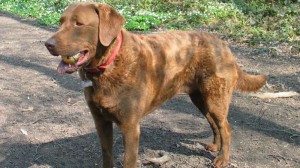Certainly, you have heard of state birds and state flowers, but did you know that a few states also have designated dog breeds? It’s not a common practice. Only 11 of the 50 states have an official dog. Some breeds, like the Alaskan Malamute, have been around for a long time. Others, such as the Boykin Spaniel, developed during the 20th century. One was bred by a president. Many were developed to serve a specific purpose, like hunting. Each breed has a unique story that tells more about the history of the place where it gained popularity. Check out the breeds.
![By SCMW (eigen werk / self-made) [CC-BY-3.0 (http://creativecommons.org/licenses/by/3.0)], via Wikimedia Commons](http://blog.explore.org/wp-content/uploads/2014/11/Alaskan_Malamute_Fotor-300x243.jpg)
By SCMW (eigen werk / self-made) [CC-BY-3.0 (http://creativecommons.org/licenses/by/3.0)], via Wikimedia Commons
![By Britta Weißenborn [GFDL (http://www.gnu.org/copyleft/fdl.html) or CC-BY-SA-3.0 (http://creativecommons.org/licenses/by-sa/3.0/)], via Wikimedia Commons](http://blog.explore.org/wp-content/uploads/2014/11/Louisiana_Catahoula_Leopard_Dog_-_Red_Leopard_Fotor-300x168.jpg)
By Britta Weißenborn [GFDL (http://www.gnu.org/copyleft/fdl.html) or CC-BY-SA-3.0 (http://creativecommons.org/licenses/by-sa/3.0/)], via Wikimedia Commons
3. Chesapeake Bay Retriever (Maryland) Legend has it that the Chesapeake Bay Retriever was bred from pooches found in a shipwreck near Maryland. Now, this breed is known for its excellent swimming ability, particularly in cold waters, and knack for retrieving birds.
4. Boston Terrier (Massachusetts) These Boston natives started out as a fighters– they were actually bred for dog fights— but the small, fun-loving canines settle into family life really well. Often called the “American Gentleman,” the Boston terrier is actually a cross between the bulldog and white English terrier (the latter is now extinct) and has made friends and fans far outside of the breed’s home state. You can find Boston terrier groups across the U.S., from North Carolina, to Texas to Nevada. 5. Chinook (New Hampshire) Like the Alaskan Malamute, the Chinook excels with sleds. This dog was developed in the 1900s by Arthur Treadwell Walden, who lived in New Hampshire, after breeding several different types of dogs for sledding. At one point in time, this breed was so rare that the Guinness Book of World Records made note of it. Since then, the number of Chinooks have climbed.![By Dr. Dominik Hessenmöller de:Benutzer:AlfredPennyworth (http://de.wikipedia.org/wiki/Bild:Plotthound.jpg) [GFDL (http://www.gnu.org/copyleft/fdl.html) or CC-BY-SA-3.0 (http://creativecommons.org/licenses/by-sa/3.0/)], via Wikimedia Commons](http://blog.explore.org/wp-content/uploads/2014/11/Plotthound_Fotor-300x225.jpg)
By Dr. Dominik Hessenmöller de:Benutzer:AlfredPennyworth (http://de.wikipedia.org/wiki/Bild:Plotthound.jpg) [GFDL (http://www.gnu.org/copyleft/fdl.html) or CC-BY-SA-3.0 (http://creativecommons.org/licenses/by-sa/3.0/)], via Wikimedia Commons
![By Jon Hurd (Flickr) [CC-BY-2.0 (http://creativecommons.org/licenses/by/2.0)], via Wikimedia Commons](http://blog.explore.org/wp-content/uploads/2014/11/Great-Dane-300x168.jpg)
By Jon Hurd (Flickr) [CC-BY-2.0 (http://creativecommons.org/licenses/by/2.0)], via Wikimedia Commons
![wikipedia user TrueBlueLacys [GFDL (http://www.gnu.org/copyleft/fdl.html) or CC-BY-SA-3.0 (http://creativecommons.org/licenses/by-sa/3.0)], via Wikimedia Commons](http://blog.explore.org/wp-content/uploads/2014/11/Blue_Lacy_3_Fotor-300x168.jpg)
wikipedia user TrueBlueLacys [GFDL (http://www.gnu.org/copyleft/fdl.html) or CC-BY-SA-3.0 (http://creativecommons.org/licenses/by-sa/3.0)], via Wikimedia Commons
![By Peter Wadsworth (Flickr) [CC-BY-2.0 (http://creativecommons.org/licenses/by/2.0)], via Wikimedia Commons](http://blog.explore.org/wp-content/uploads/2014/11/American_Foxhound_and_Labrador_Retriever_playing_Fotor-300x187.jpg)
By Peter Wadsworth (Flickr) [CC-BY-2.0 (http://creativecommons.org/licenses/by/2.0)], via Wikimedia Commons
![By Awsguy1 (Own work) [GFDL (http://www.gnu.org/copyleft/fdl.html) or CC-BY-SA-3.0-2.5-2.0-1.0 (http://creativecommons.org/licenses/by-sa/3.0)], via Wikimedia Commons](http://blog.explore.org/wp-content/uploads/2014/11/americanwaterspaniel-300x168.jpg)
By Awsguy1 (Own work) [GFDL (http://www.gnu.org/copyleft/fdl.html) or CC-BY-SA-3.0-2.5-2.0-1.0 (http://creativecommons.org/licenses/by-sa/3.0)], via Wikimedia Commons
Of course, there are other dogs closely associated with specific states, even if they haven’t been designated as the official canine. Take the kyi-leo for example. That’s a relatively new breed– it only began to develop in the mid-20th century– and the tiny dogs are pretty rare. However, this breed’s roots are tied to northern California, where a lhaso apso and maltese mated. Maybe Georgia would like to adopt the American bulldog, who was brought back from the brink of extinction by a man from the state. Which dog breed do you think belongs to your state?
EXPLORE the Complete – Service Dog Project Live Camera Experience


![By Chitrapa at en.wikipedia [Public domain], from Wikimedia Commons](http://blog.explore.org/wp-content/uploads/2014/11/Boston-300x168.jpg)
![By jude (Flickr) [CC-BY-2.0 (http://creativecommons.org/licenses/by/2.0)], via Wikimedia Commons](http://blog.explore.org/wp-content/uploads/2014/11/Chinook_Olympics_07_136_Fotor-300x168.jpg)
![By Flatscaster at en.wikipedia [Public domain], from Wikimedia Commons](http://blog.explore.org/wp-content/uploads/2014/11/Boykin_spaniel_Fotor-300x168.jpg)


